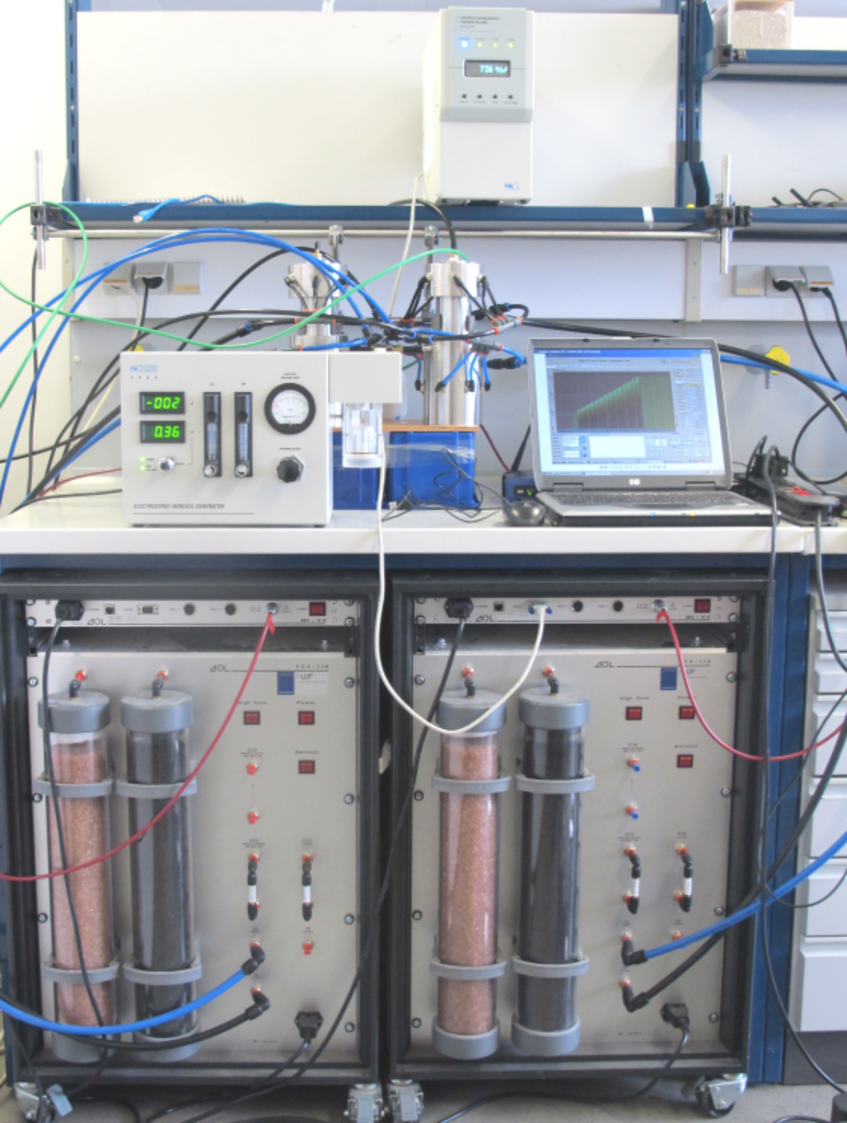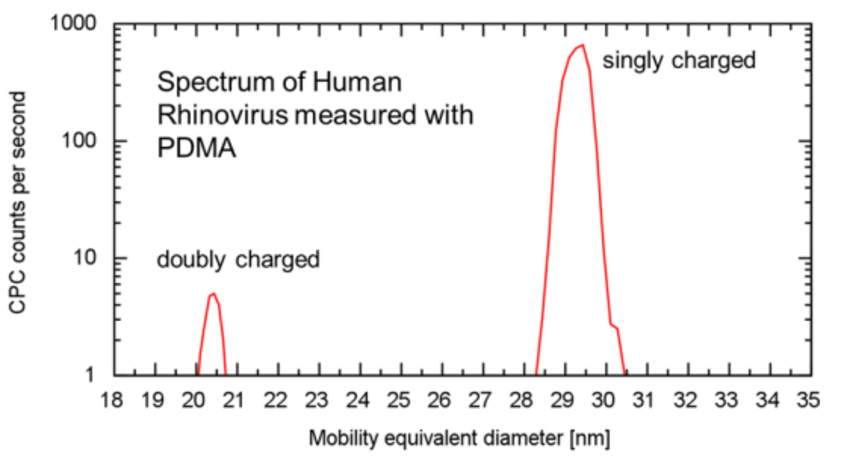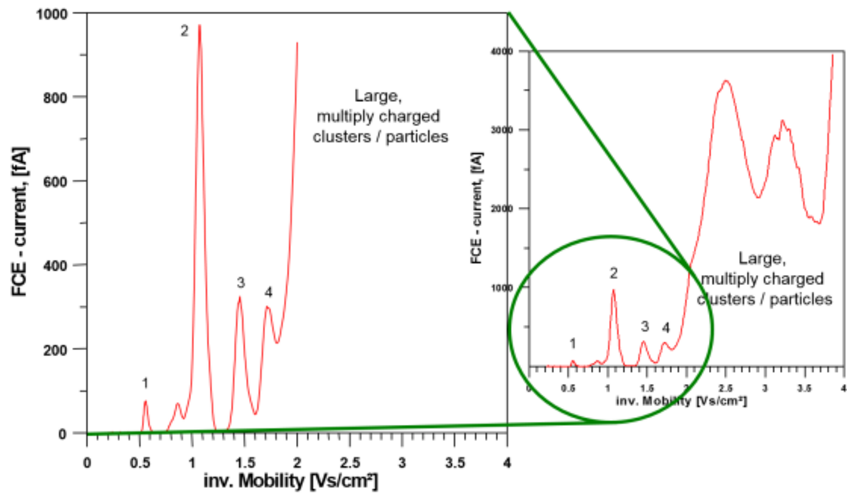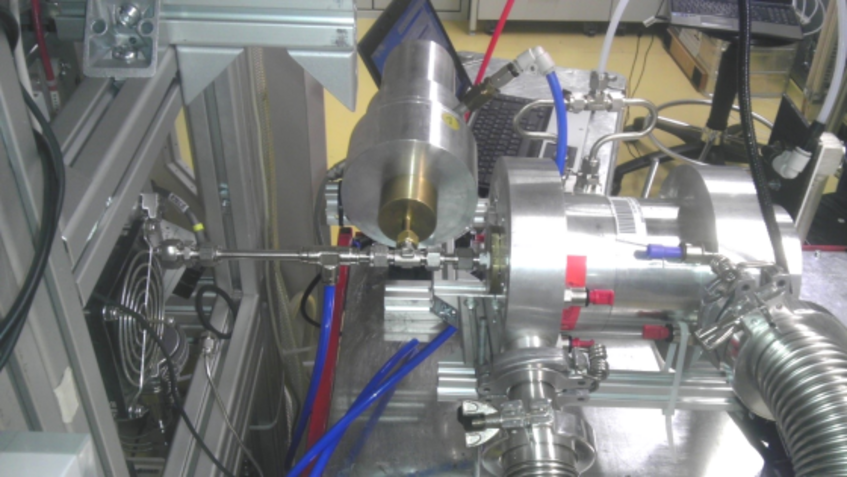Development of new measurement methods for the characterization of nanometer-sized particles
The development of new instrumentation, especially for ultrafine aerosol (the size range below 100nm) has got a long tradition in Vienna. Most prominently, the Electrical Mobility Spectrometry (EMS), was significantly improved in Vienna, introducing the so called Vienna-type Differential Mobility Analyser (DMA) (Reischl, 1991; Winklmayr et al., 1991). Nowadays, the Vienna-type DMA is used in many research and academic institutions all over the world.
Electrical Mobility Spectrometry, EMS
Electrical Mobility Spectrometry is a measurement technique where charged conditioned particles and ionic clusters are classified according to their electrical mobility at ambient pressure. The core component for electrostatic mobility measurements is the so called Differential Mobility Analyser (DMA). Most commonly, DMAs are based on a cylindrical capacitor geometry; such as the Vienna-type. One remarkable feature of the DMA is the possibility to use it as an analysing device as well as a classifying instrument. Together with an appropriate detection instrument, a DMA allows the measurement of individual electrostatically separated charged nanoparticles and ionic molecular clusters. Also, together with an appropriate aerosol generator, it can be used to classify one specific mobility band out of a broad particle distribution to serve as a source of monodispersed particles.
Nano differential mobility analyser, NDMA & Parallel differential mobility analyser, PDMA
The NDMA is a redesign of the original Vienna-type DMA with a short channel length of about 15mm and an aspect ratio L/(R2-R1) of about 2. It is especially designed for an improved operation in the size range below 10nm compared to the original Vienna DMA (L=110mm, aspect ratio: 13.75).
The PDMA (Patent AT502207A1, WO2007016711A1) is an enabling structure based on the DMA principle: Parallel with a scanning DMA 1 that scans and delivers the complete size spectrum of the investigated particles, an identical separation unit DMA 2 can be in operation and set to one given voltage value (separation) and used for sampling or enrichment (collection) of the one selected size class of particles, hence the acronym PDMA. (Wasiak et al. 2016, Weiss et al. 2015, Kallinger and Szymanski, 2015, Allmaier et al., 2008, 2014)
High resolution ultra-fine differential mobility analyser, UDMA
The UDMA (Steiner et al. 2010) is an advancement of the Vienna-type NDMA, especially designed for high resolution mobility measurements of charged particles and ionic molecular clusters. A channel length of 6mm and an aspect ratio of 1 reduced the residence time of clusters and particles in the DMA to a minimum, therefore reducing the diffusion-broadening of the DMAs transfer function. At typical operating conditions, the UDMA achieves a resolution between 15 and 20 in the sub 3nm size range. The resolution R is defined as R = Z*/ΔZ, where Z* is the electrical mobility corresponding to the peak of the transfer function and ΔZ is the full width at half maximum (FWHM) of the transfer function.
This size range has become of special interest in the last years, since it also covers the first steps of new particle formation in the atmosphere; a process that strongly contributes to Earth’s radiative balance and therefore a key-player in global climate change.
With the UDMA, we are performing studies that focus on the evaluation of the properties of airborne molecular clusters, generated by the ionizing radiation of commonly used aerosol chargers (Steiner and Reischl; 2012; Kallinger et al., 2012; Steiner et al. 2014). Because of its high resolution power we are using it as source of highly monodisperse test clusters or test aerosols (e.g. Winkler et al. 2008, 2012).
In this context, we are actively collaborating worldwide with a number of different working groups by offering the use of the UDMA for calibration purposes. Current research focuses on the development of new generation techniques for charged and also neutral calibration clusters.
Fig. 3 Electrical mobility spectrum (Faraday Cup Electrometer (FCE) current vs. inverse electrical mobility) of negatively charged electrospray generated clusters of the ionic liquid tributylmethylammonium bis(trifluoromethanesulfonyl) imide. Each peak in the spectrum corresponds to one specific molecular cluster-species.
Fig. 4 The Vienna UDMA connected to the Frankfurt CI-APi-TOF-MS (Chemical Ionization Atmospheric Pressure interface Time-Of-Flight Mass Spectrometer) during a measurement campaign in March 2015. The UDMA was used as supply of ionic calibration clusters of known electrical mobility, mass and number concentration to characterize the total ion transmission efficiency of the Frankfurt instrument.
Faculty:
Mag. Dr. Gerhard Steiner
Ao. Univ.-Prof i.R. Dr. Wladyslaw Szymanski
References:
Allmaier, G., Laschober, C. and Szymanski, W.W. (2008) Nano ES GEMMA and PDMA, new tools for the analysis of nanobioparticles ‐ Protein complexes, lipoparticles, and viruses. J. America. Soc. Mass Spectrometry 19, 1062‐1068.
Allmaier, G., Weiss, V.U., Havlik, M., Kallinger, P., Marchetti-Deschmann, M., Szymanski, W.W.(2014) Analysis of bio-nanoparticles by means of nano ES in combination with DMA and PDMA: Intact viruses, virus-like-particles and vaccine particles. NATO Science for Peace and Security Series A: Chemistry and Biology, Vol. 33, 2014, p. 133-147
Kallinger, P., Steiner, G., Szymanski, W.W. (2012) Characterization of four different bipolar charging devices for nanoparticle charge conditioning, J. Nanopart. Res., 14, I 6.
Kallinger, P., Szymanski, W.W. (2015) Experimental determination of the steady-state charging probabilities and particle size conservation in non-radioactive and radioactive bipolar chargers in the size range of 5-40nm. Journal of Nanoparticle Research 17, Issue 4, 2-13, 2015.
Reischl, G.P. (1991). Measurement of Ambient Aerosols by the Differential Mobility Analyzer Method: Concepts and Realization criteria for the Size Range between 2 and 500 nm. Aerosol Sci. Technol., 14, 5
Steiner G. and Reischl G.P. (2012) The effect of carrier gas contaminants on the charging probability of aerosols under bipolar charging conditions. J. Aerosol Sci , 54, 21-31
Steiner, G., Attoui, M., Wimmer, D. and Reischl, G.P. (2010). A Medium Flow, High Resolution Vienna DMA running in Recirculating Mode. Aerosol Sci. Technol., 44: 4, 308 – 315
Steiner, G., Jokinen T., Junninen, H., Sipilä, M., Petäjä, T., Worsnop, D.R., Reischl, G.P. and Kulmala M. (2014) Combined high resolution mobility and mass spectrometry of ions produced in an 241Am aerosol charger, Aerosol Sci. Technol., 48:3, 260-269
Wasiak I., Kullowska, A., Janczewska, M., Michalak, M., Cymerman, I.A., Nagalski, A., Kallinger, P., Szymanski, W.W., Ciach, T. (2016) Dextran Nanoparticle Synthesis and Properties. PLOS One 11 (1), 1-17, 2016, doi: 10.1371/journal.pone.0146237.
Weiss, V.U., Bereszazk, J.Z., Havlik, M., Kallinger, P., Gösler, I., Kumar, M., Blaas, D., Marchetti-Deschmann, M., Heck, A.J., Szymanski, W.W., Allmaier, G. (2015) Analysis of a common cold virus and its subviral particles by gas-phase electrophoretic mobility molecular analysis and native mass spectrometry. Analytical Chemistry 87, (17), 2015, doi: 10.1021/acs.analchem.5b01450
Winkler, P.M., Steiner, G., Vrtala, A., Vehkamäki, H., Noppel, M., Lehtinen, K.E.J., Reischl, G.P., Wagner, P.E. and Kulmala, M. (2008). Heterogeneous nucleation experiments bridging the scale from molecular ion clusters to nanoparticles. Science, 319, 5868, 1374-1377
Winkler, P.M., Vrtala, A. Steiner G., Wimmer, D., Vehkamäki, H., Lehtinen, K.E.J, Reischl, G.P., Kulmala, M and Wagner, P.E. (2012) Quantitative characterization of critical nanoclusters nucleated on large single molecules, Phys. Rev. Let., Vol.108, No. 8
Winklmayr, W., Reischl, G.P., Lindner, A.O. and Berner A. (1991). A New Electromobility Spectrometer for the Measurement of Aeorosol Size Distribution in the Size Range from 1 to 1000 nm J. Aerosol Sci, 22, 289




